Range Resources Corporation (NYSE:RRC) is an Appalachian natural gas and natural gas liquids producer that has weathered considerable lows in the sector and region. Given its nearly 50% increase in share price and market cap from a year ago and minimal dividend of 0.9%, I am downgrading it from Buy to Hold.
Energy investors looking for capital appreciation should monitor Range for a lower-cost entry point. As fellow Seeking Alpha contributor Leo Nelissen points out, the company’s $1.1 billion in buyback authorization could also provide support to the stock price.
Note that the company achieved this share and market cap increase despite reserve value falling by two-thirds (due to far lower gas prices) and 2023 Marcellus gas prices dropping so low some producers shut in new production. Range has achieved its good results due in part to its recovery and sales of co-produced natural gas liquids.
Range Resources First Quarter 2024 Results and Guidance
In the first quarter of 2024 Range Resources’ net income was $92 million, or $0.38/diluted share.
Cash flow from operating activities for the quarter was $332 million, and capital expenditures were $170 million.
Range produced 2.14 BCF-equivalent/day (BCFe)/day, about 68% of which was natural gas. Specifically, this divides as 1.46 BCF/day of natural gas, 107,300 barrels per day (BPD) of natural gas liquids, and 6700 BPD of oil.
Including the impact of hedges and derivatives settlement, Range’s 1Q24 natural gas, NGLs and oil price realizations averaged $3.54/mcfe (mcf-equivalent). After third-party transportation costs, the realization averaged $2.05/mcfe.
In its investor presentation, Range Resources highlights:
- *30+ years of core Marcellus inventory
- *sustainable free cash flow at low prices due to “low capital intensity, liquids revenue, and hedging”
- *diversified domestic and international market for gas and natural gas liquids
- *reduction of its net debt from $4.1 billion in 2017 to $1.4 billion in 1Q24.
Range has 70,000 acres in northeast Pennsylvania and 440,000 acres in southwest Pennsylvania.
Range Resources investor presentation
Macro
The big initial pop for U.S. liquified natural gas (LNG) when Russian gas dropped out of the European market has subsided.
A bigger issue is U.S. policy: although Europe and Asia still seek LNG supplies, the Biden administration has halted permitting on all new LNG export terminals in the U.S. Gas prices fell so low in the Marcellus recently that some producers chose to shut in production or not complete new wells.
Today’s lower gas prices increase demand for gas as a generating fuel in electric power, where it is competitive with coal but offering lower emissions. Less recognized is that the closure of U.S. coal plants gives more support to natural gas prices, since coal was long a competitor to natural gas in generation.
In the power sector, there is also the increased realization that gas, because of its fast-off, fast-on characteristics, is a better backup for intermittent renewables than coal or nuclear. (Some grid experts recommend a 1.1:1 redundancy of gas generation for solar and wind generation to ensure grid stability.)
Another key factor: as artificial intelligence applications within data centers line up for more electricity, natural gas and nuclear (and coal, where available) plants meet the increased generation needs for this 24/7 demand.
U.S. Gas Prices, Production, and Demand
The May 8, 2024, natural gas futures price for June 2024 delivery was $2.19/MMBTU at Henry Hub, Louisiana.
The EIA projects Henry Hub gas prices averaging around $3/MMBTU through the end of 2025 and note the general upward trend. The 5-95 confidence interval for year-end 2025 is $2/MMBTU and $9.50/MMBTU. Both are illustrated in the second graph below.
EIA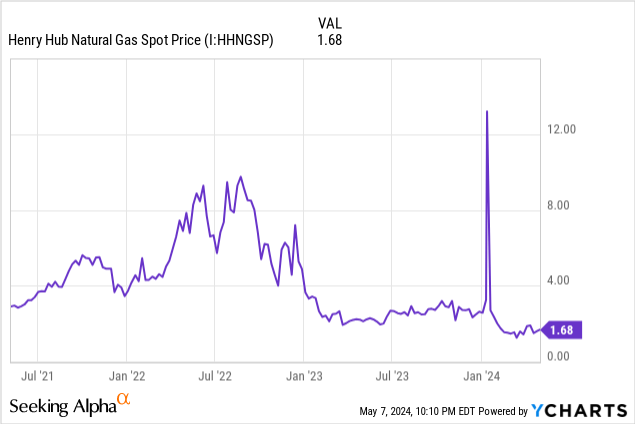
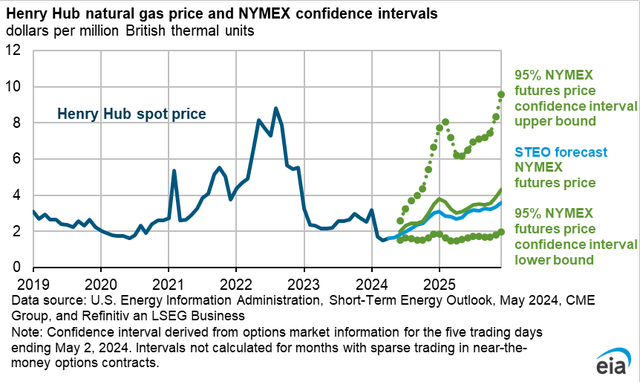
Total U.S. dry natural gas production for the week ending May 1, 2024, was 99.2 BCF/D.
Appalachian gas volumes (the green-colored Marcellus and the rust-colored Utica) are estimated to be 36.2 BCF/day in April 2024, about 36% of April’s U.S. gas production of 100.2 BCF/D.
EIA Natural Gas Weekly
The map illustrates the Marcellus formation.
Penn State Marcellus Center for Outreach and Research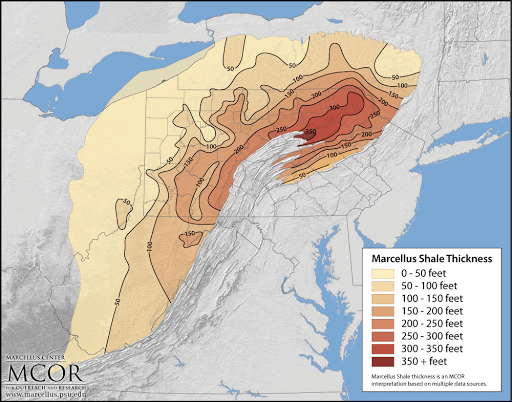
For the week ending May 1, 2024, U.S. natural gas demand totaled 95.4 BCF/D. This varies throughout the year depending on the weather.
Natural Gas Weekly and Starks Energy Economics, LLC
Natural Gas Liquids
NGLs (ethane, propane, and butane) are used to make ethylene, a critical petrochemical building block, and for heating and drying. Range also gets significant price uplift from its NGL production.
Range Resources’ Reserves
Range Resources’ year-end 2023 total year-end proved reserves were 17.4 trillion cubic feet-equivalent (TCFe), dividing as 10.9 TCF of natural gas, 1.0 billion barrels of natural gas liquids, and 42.9 million barrels of crude oil and condensate.
Proved developed reserves were 11.0 TCFe, or about 63% of the total.
As predicted in my report last year on Range (and everyone else with gas reserves), since 2022 gas prices were so extraordinarily high the price component of the 2023 reserve measure, and thus the entire 2023 reserve value, was lower.
December 31, 2022, PV-10 of Range’s reserves were $24.5 billion. Year-end 2023’s PV-10 value was $7.8 billion, or less than a third of the 2022 value.
Competitors
Range Resources is headquartered in Fort Worth, Texas. Although poor gas price economics inhibited the Appalachian natural gas sector for years, several other companies also remain, including Antero Resources (AR), Chesapeake (CHK), CNX (CNX), Coterra (CTRA), EOG (EOG) with its new Utica Combo play, EQT (EQT), National Fuel Gas (NFG) also in the Utica combo, Ovintiv (OVV), Spanish company Repsol (OTCQX:REPYY), and Southwestern Energy (SWN), which Chesapeake is trying to acquire.
Other companies in the Utica Combo play in addition to those mentioned above are several private companies and Gulfport Energy (GPOR).
Appalachian natural gas is disadvantaged to natural gas in Louisiana, Texas, and Oklahoma due to Appalachian and mid-Atlantic pipeline takeaway constraints for meeting Gulf Coast industrial, power, Mexican export, and LNG export demand. However, if the 2 BCF/D Mountain Valley Pipeline begins operations as expected at the end of May (waiting on FERC approval), this bottleneck will be somewhat alleviated. In the past months, when gas prices dipped very low, some companies also shut in Appalachian production.
As the large U.S. Permian Basin matures, more of its production will be gas and associated gas—rather than oil—which also puts downward pressure on prices. Already, Permian associated gas (produced along with the more valuable oil) depresses gas prices since its marginal price is effectively zero.
Governance
On May 1, 2024, Institutional Shareholder Services ranks Range Resources’ overall governance as an excellent 1, with sub-scores of audit (1), board (2), shareholder rights (1), and compensation (2). On the ISS scale, 1 represents lower governance risk and 10 represents higher governance risk.
Insiders own 2.5% of the stock. On April 15, 2024, shorted stock as a percentage of float is 9.0%.
Range Resources’ beta is 1.88. While much more volatile than the overall market, this is in line for an independent gas producer.
On December 31, 2023, the five largest institutional stockholders, some of which represent index fund investments that match the overall market, were T. Rowe Price (16.1%), Fidelity/FMR (14.6%), Vanguard (9.7%), BlackRock (9.3%), and State Street (4.3%).
T. Rowe Price, BlackRock, and State Street, (but not Fidelity or Vanguard) are signatories to the Net Zero Asset Managers initiative, a group which manages $57 trillion in assets worldwide and which limits hydrocarbon investment via its commitment to achieve net-zero alignment by 2050 or sooner.
Financial and Stock Highlights for Range Resources
Using Range’s May 8, 2024, closing stock price of $36.97share, the market capitalization is $9.0 billion, about 50% higher than a year ago.
With a 52-week price range of $24.61-$38.25/share, the closing price is 97% of the 52-week high and of the one-year target of $38.21/share.
Range’s trailing twelve months’ (TTM) returns on assets and equity are 7.3% and 13.5%, respectively. Trailing twelve months’ EPS is $2.00 for a current price/earnings ratio of 18.5.
Analysts’ average estimates for 2024 and 2025 EPS are $2.34 and $3.47, respectively, giving a forward P/E range of 10.7-15.8.
TTM operating cash flow was $835 billion and levered free cash flow was $29 million.
On March 31, 2024, the company had $3.545 billion in liabilities and $7.372 billion in assets, slightly moderating Range’s liability-to-asset ratio from 52% a year ago to 48% now. (#s from 1Q24 report)
Of the liabilities, current liabilities are $625 million and senior notes are $1.76 billion.
The ratio of debt to EBITDA is 1.6.
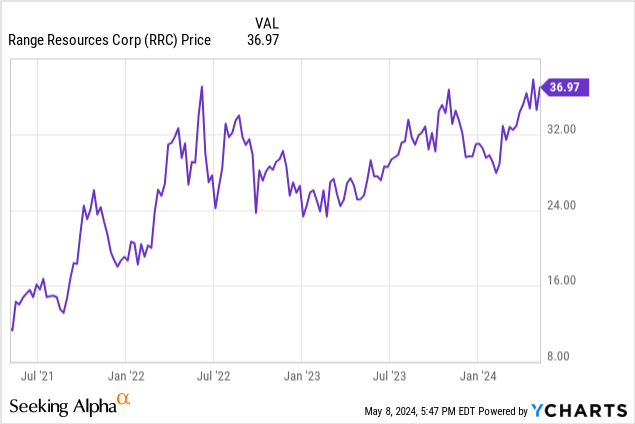
Range Resources pays a small dividend, $0.32/share, for a dividend yield of 0.9%. Its remaining stock repurchases authorization is $1.1 billion.
The mean analyst rating is a 2.1, or “Buy,” from 34 analysts.
Notes on Valuation
The company’s book value per share of $15.77, about 40% of its market price, suggests positive investor sentiment.
With an enterprise value (EV) of $10.6 billion, Range’s EV/EBITDA ratio is 8.7, less than the preferred maximum of 10 or less and so in bargain territory.
So overall, Range Resources has
- *a market capitalization of $9.0 billion,
- *an enterprise value of $10.6 billion,
- *reserves with a PV-10 value of $7.8 billion, and
- *a balance sheet asset value of $7.4 billion.
Positive and Negative Risks
Investors should consider their natural gas and natural gas liquids price and demand expectations—especially in Appalachia with its limited takeaway capacity despite the expected addition of Mountain Valley Pipeline—as the factors most likely to affect Range.
Other risks are political and regulatory—particularly with the Biden administration, bankers including three of Range’s largest institutional investors, and several states on the East Coast—Range’s natural market—still taking a race-to-zero-hydrocarbons posture. Moreover, the Biden administration has paused permitting on new LNG export terminals, a sector that had promised significant gas demand growth.
The increased demand for natural gas as an electric generation fuel for growth in data centers and AI is a positive. Also, as U.S. coal plants are closed, coal as a competitor fuel for electric generation becomes less of a factor in the U.S.
Recommendations for Range Resources
Range Resources is a Marcellus gas producing company seeing upside from its liquids production and sporting an excellent governance score. Like its Marcellus competitors, Range should see price relief if 2 BCF/D Mountain Valley Pipeline begins operations in late May as planned. This depends on FERC approval.
Due to a small dividend yield, I do not recommend Range Resources Corporation stock to dividend-seeking investors.
Investors focused on capital appreciation may want to wait for a lower cost entry point. After its significant stock price run-up in the last year, I am downgrading Range Resources from Buy to Hold.
I own shares.
Range Resources
Editor’s Note: This article discusses one or more securities that do not trade on a major U.S. exchange. Please be aware of the risks associated with these stocks.
Read the full article here





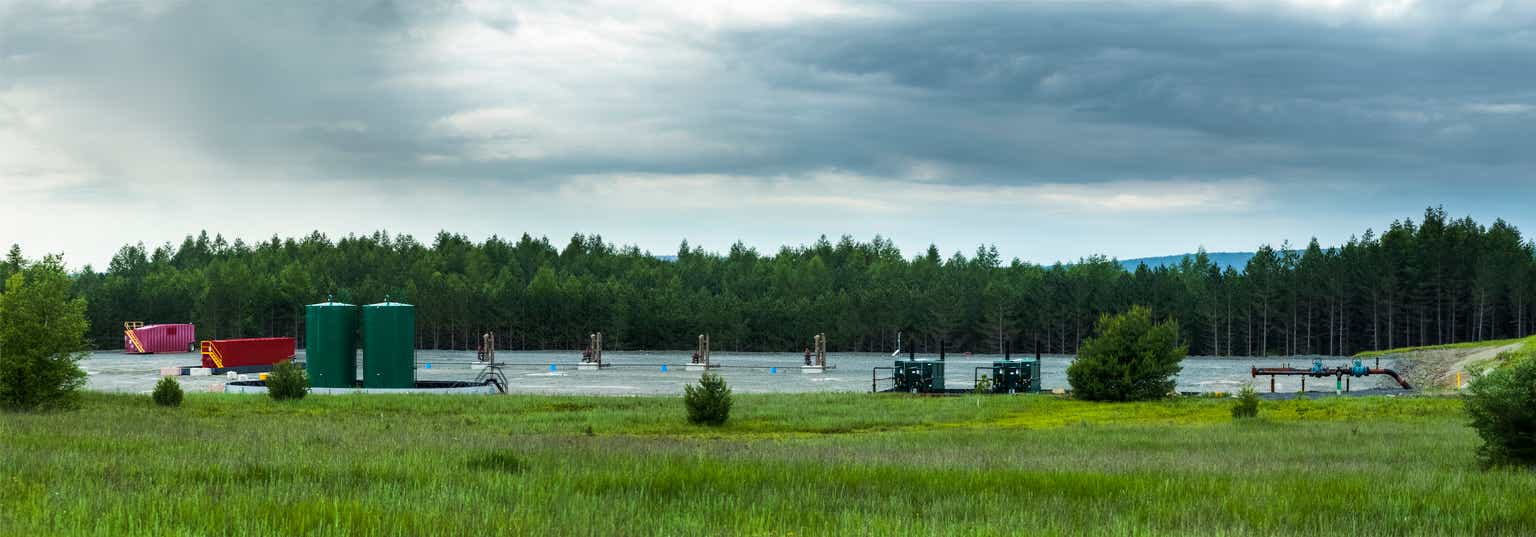



Leave a Reply